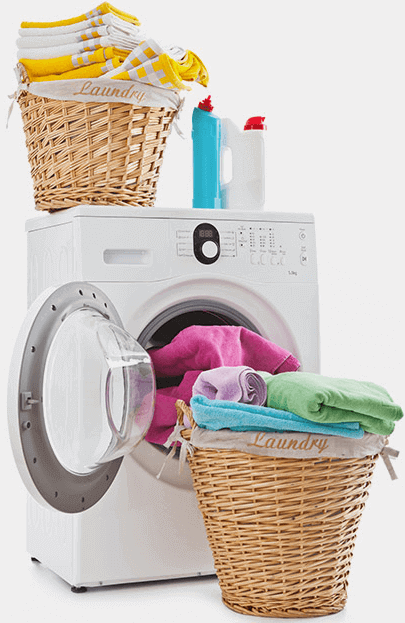There are many myths and misconceptions regarding the dry cleaning industry, the actual dry cleaning process, and the chemicals used during dry cleaning. Industry-specific knowledge, education, and extensive training are absolutely necessary to be truly skilled in operating a responsible dry cleaning business.
What is dry cleaning?
Although called dry cleaning, dry cleaned items do get wet, just not with water. There is little to no moisture used during the dry cleaning process, which gives the process it’s “dry” cleaning description. A dry cleaning machine resembles a very large, highly technical, front-loading washing machine. Items are cleaned in a solvent, using a tumble action process. There is no mystery tunnel as some imagine exists behind the scenes.
Prior to cleaning, all items are sorted by type – garments, households (such as comforters and bedspreads), etc. Once these categories are established, items are sorted according to various factors that require different care methods – colors, delicate fabrics, decorations such as beading and sequins, etc.
Spots and stains are attended to prior to cleaning. However, all reputable dry cleaners will have stations in place to inspect garments after cleaning for any remaining spots or stains, and prior to delivery to the customer. Some garments may need to have spots removed after the initial cleaning process, and will then need to be cleaned again.
Items are then placed into the dry cleaning machine which has a door and a drum (or wheel), much like a front-loading washing machine. And, like a front-loading washing machine, the dry cleaning machine cleans using a tumble action process. The duration of cycles and speeds of cycles can be adjusted based on the requirements of the load.
Both cleaning and drying steps are all completed in one cycle, within the same machine. Items go into the machine dry, and they come out of the machine dry.
Dry cleaning is effective in removing grease-based stains such as body oil, salad dressing, candle wax, etc. Because there is little to no moisture in the process, it greatly reduces the risk of shrinkage in items and garments.
Wet Cleaning
Wet dry cleaning is a highly effective method of cleaning a moderate percentage of Dry Clean Only items using a water-based process. Wet cleaning is drastically different from traditional laundering, though. Wet cleaning machines use precise water temperatures and cycle speeds (cleaning, extraction, etc.). Both of these factors greatly reduce the possibility of stretching and fabric damage.
While wet cleaning cannot completely replace traditional dry cleaning, it is an excellent option for removing water-soluble stains such as soda, dirt, mud, blood, urine, etc. It also works very well in removing odors such as smoke and body odor.
Some garments with delicate trim cannot be dry cleaned, as solvents may damage items such as beads and sequins. Wet cleaning is a possible alternate cleaning method for these types of garments.
Finishing
Once a garment is cleaned, it moves into the Finishing Department. Individuals are trained to press specific garments, removing any wrinkles and creases. Prior to delivery to the customer, all items are inspected to ensure no wrinkles or creases remain, and that all stains which are able to be removed have been attended to.
What chemicals are used in Dry Cleaning?
All dry cleaning processes require the use of a solvent. There are several varieties of dry cleaning solvents available, all of which are carbon-based. Anything carbon-based is considered organic dry cleaning. Dry cleaners who promote themselves as organic dry cleaners are technically correct in saying so, however not in the sense a consumer would think. Those who promote themselves as organic are further perpetuating a false narrative that already exists among consumers.
Yes, some dry cleaning solvents are safer than others when it comes to handling, storage, and disposal. At Classic Drycleaners, we use a heated hydrocarbon dry cleaning solvent which has more lenient guidelines and is not labeled as a probable carcinogen by the Environmental Protection Agency.
The question many consumers ask is, “Is dry cleaning safe?” The answer is yes. However, as with any solvents and cleaners, including household cleaners sold in grocery stores, products are only safe when manufacturer recommended guidelines are followed for appropriate use, storage, and disposal.
Minimizing the Carbon Footprint
There are many factors that contribute to any business, including dry cleaners, being deemed “green” businesses. What programs and procedures are in place to minimize waste and utility usage, maximize recycling, and reduce the company’s overall carbon footprint? For dry cleaners, using an “organic” solvent is simply not enough when using the terms “best green dry cleaners” or “eco-friendly dry cleaners” when promoting their services and business to consumers.
At Classic Drycleaners, we have multiple recycling programs in place to help reduce waste and minimize our impact on the environment. All metal hangers returned by our customers are either reused or delivered to a qualified recycling facility by our local scrap metal recycling partner.
For over 10 years, Classic Drycleaners has partnered with the Trex Company to recycle all dry cleaning plastic returned by our customers. The Trex Company combines sawdust (which means they do not cut down trees) with plastic bags (such as newspaper bags, paper towel wrappers…and our drycleaning bags) to create composite decking materials.
All of our dry cleaning stores and laundromats have recycling programs in place for employee and consumer-based recycling items such as paper, detergent containers, etc.
In addition to formal recycling programs, it is imperative that businesses identify areas and implement steps to reduce utility usage. At Classic Drycleaners, our washers use minimal water and are designed to provide powerful cleaning using less detergent and electricity. Our utility-saving efforts (innovation, extensive renovations projects, etc.) have been recognized by the USGBC Central Pennsylvania, as well as UGI Utilities.
All industries are different, and businesses must find unique and innovative ways to be socially responsible. For example, in addition to recycling programs and energy-efficient equipment and processes, Classic Drycleaners exclusively offers ZeroCarbonTM cleanings and preservations. As a member of the Association of Wedding SpecialistsTM, the carbon footprint created by the cleaning and preservation process is covered by our donation to Carbonfund.org.
Choosing a Drycleaner you can Feel Good About
When choosing a company to support, both financially with your business and socially within your community, take into consideration a variety of factors.
If environmental responsibility is important to you and your family, does the company have active programs in place to reduce waste? Do they recycle and have utility minimization programs in place? Overall, the company should be taking steps to identify areas for improvement and implementing programs to achieve success.
At Classic Drycleaners and Laundromats, we continually monitor existing recycling programs and utility usage. Our equipment is regularly maintained. Additionally, we seek out opportunities to add to our existing programs, procedures, and equipment through innovation and technology.
Come see us for yourselves at one of our eight great locations or talk to us online through our contact page!



